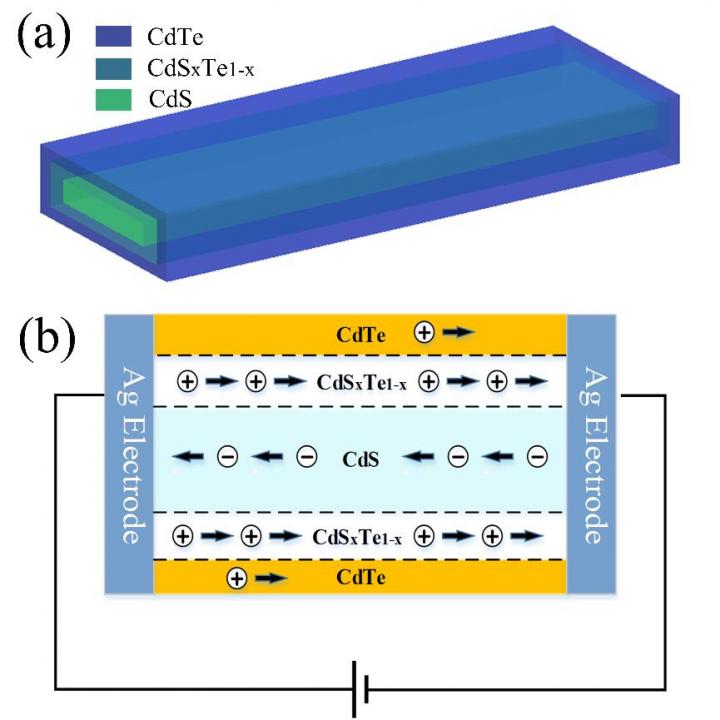Fast visible-UV light nanobelt photodetector

(a) The schematic diagram of CdS-CdSxTe1-x-CdTe nanobelts. (b) Schematic diagram of electron-hole pair separation and transfer in the CdS-CdSxTe1-x-CdTe heterostructure photodetector. Credit: ©Science China Press
As a representative II-VI semiconductor, CdS is a promising material for visible-UV light detection. However, for pure NWs/NBs based photodetectors, fast photoresponse speed and high sensitivity cannot be achieved simultaneously because of the surface reaction.
Recently, group of Qing Yang in Zhejiang University demonstrates a CdS-CdSxTe1-x-CdTe core-shell nanobelt photodetector, which possesses both high sensitivity and fast speed. The CdS-CdSxTe1-x-CdTe nanobelts were fabricated by introducing CdTe in the growth of CdS nanobelt.
Because of the special growth condition, ternary crystal CdSxTe1-x alloy layers was formed between CdS and CdTe layers, thus CdS-CdSxTe1-x-CdTe core-shell structure was obtained. The fastest response time of this photodetector was demonstrated to be 11us, which is the fastest nanobelt photodetector based on CdS.
The improvement of the response speed is ascribed to the forming of heterojunction among CdS, CdSxTe1-x and CdTe layers, which suppresses the surface reaction. In addition, the detection light spectrum has covered a wide range from 355 to 785 nm. Compared with pure CdS or CdTe nanostructure-based photodetectors, the detection spectrum of this photodetector is much extended, covering the whole visible spectrum.
The responsivity and 3 dB bandwidth of the nanobelt photodetector reaches up to 1520 A/W and 22.9 KHz, respectively. Considering the simple fabrication process and the high performance in responsivity, response speed and detection spectrum, the CdS-CdSxTe1-x-CdTe NB photodetectors will find wide applications in optoelectronic nano devices such as optical communications, sensing and imaging.
###
See the article:
Tang M, Xu P, Wen Z, et al. Fast response CdS-CdSxTe1-x-CdTe core-shell nanobelt photodetector. Sci. Bull. (2018) https:/
https:/
Media Contact
More Information:
http://dx.doi.org/10.1016/j.scib.2018.08.003All latest news from the category: Physics and Astronomy
This area deals with the fundamental laws and building blocks of nature and how they interact, the properties and the behavior of matter, and research into space and time and their structures.
innovations-report provides in-depth reports and articles on subjects such as astrophysics, laser technologies, nuclear, quantum, particle and solid-state physics, nanotechnologies, planetary research and findings (Mars, Venus) and developments related to the Hubble Telescope.
Newest articles

A universal framework for spatial biology
SpatialData is a freely accessible tool to unify and integrate data from different omics technologies accounting for spatial information, which can provide holistic insights into health and disease. Biological processes…

How complex biological processes arise
A $20 million grant from the U.S. National Science Foundation (NSF) will support the establishment and operation of the National Synthesis Center for Emergence in the Molecular and Cellular Sciences (NCEMS) at…

Airborne single-photon lidar system achieves high-resolution 3D imaging
Compact, low-power system opens doors for photon-efficient drone and satellite-based environmental monitoring and mapping. Researchers have developed a compact and lightweight single-photon airborne lidar system that can acquire high-resolution 3D…





















